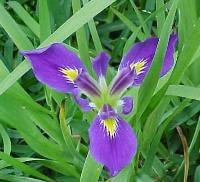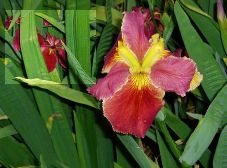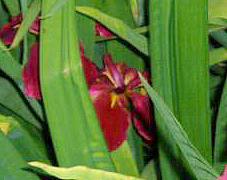Images and reflections by Dick Sloan
Note the red iris to the left of 'High Rank', in the background. This is a bloom on an Iris nelsonii. I. nelsonii is limited to a small area of swamp near Abbeville, LA, discovered by W.B. Macmillan, a iris and daylily breeder, about 1938. These irises, mostly red shades but some yellow, brownish or lilac tints, were called Abbeville Reds, Abbeville yellows, or Super Fulvas (for their improvement in red color over I. fulva), until given species status, as a stable natural hybrid between I. fulva and I. giganticaerulea, the tall blue or white native iris of the marshy land along the gulf coast. These Abbeville forms probably were the greatest force in hybridizing, begun seriously in the 1950's, due to their color and large impressive blooms. Many are still grown in gardens because they are beautiful in their own right.
Iris nelsonii was named for Ike Nelson, of the university in Lafayette, who was a leader in the early Louisiana iris society and died young in a car accident. His wife Barbara, one of our three charter member women who remain, still lives in Lafayette. I use the term 'university in Lafayette', now University of Louisiana - Lafayette, because it has had various names over its history.
In addition to I. fulva, I. giganticaerulea, and I. nelsonii, there are two other Louisiana species. Iris brevicaulis has, normally, blue flowers on shorter zig-zag stems. It and I. fulva grow up the Mississippi valley farther north than the others. Iris hexagona inhabits the southeastern Atlantic and Gulf coasts. Research is now on-going to determine if many native irises of Florida, long thought to be all I. hexagona, may actually consist of a new or more than one new species. These five species make up the series Hexagonae, one of 15 series in the subsecton Apogon (beardless) of the genus Iris. There are approximately 200 species of irises, all native to the northern hemisphere.
 |
Iris brevicaulis Iris fulva |
 |
It is easy to see, from the I. nelsonii shown at the top of the page, how breeding has enlarged the blooms of the species, adding frills and fancies. We are fortunate that no serious diseases have hurt the plants, and future breeding must look to preserve this. Daylilies are just now under attack from an imported rust. Bearded irises suffer from various leaf fungi and bacterial rot diseases which make them a challenge. Louisianas do have some fungi on the leaves. It seems to come and go according to the season, depending on weather, and isn't a problem for the home gardener. In the north iris borers will attack any iris in the region of the country where they exist -- thankfully for most Louisiana growers this area does not include the south or far west. The borer/moth insect seems unable to survive those climates.
From The Heart | Contrasts | The Arkansas Hybridizers | From Australia
The Ladies | Hues | The Haymon Irises | The Species
My Introductions, Hybridizing, Seeds & Seedlings
Profile - Dick Sloan

